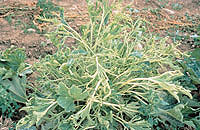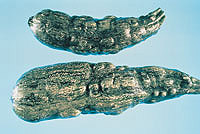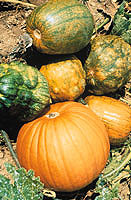Contributed by
R. Provvidenti
New York State Agricultural Experiment Station
Cornell University
Geneva, NY 14456

Zucchini yellow mosaic has come to have great economic importance since it was recognized
in 1981. The causal agent, zucchini yellow mosaic virus (ZYMV), was reported almost simultaneously in Italy and France, where it was named muskmelon yellow stunt virus. Presently, it is known to occur in 22 countries on five continents, where it has often caused devastating epidemics.
Symptoms
Cultivars of Cucurbita pepo, Cucumis melo, and Citrullus lanatus are particularly affected. The virus incites yellow mosaic, severe malformation, blisters, extreme reduction in the size of leaf lamina, necrosis, and severe plant stunting (Fig. 1). Squash and pumpkin fruit develop knobby areas, which cause prominent deformation (Fig. 2 and 3). Melon and watermelon fruit are also malformed and often develop deep longitudinal and radial cracks. Seed production is drastically reduced, and seeds are frequently deformed. Depending on the strain involved, symptoms may strongly resemble those caused by papaya ringspot virus type W (PRSV-W). In the tropics, ZYMV is often associated with PRSV-W or with watermelon mosaic virus (WMV). Serologically, it is related to WMV but not to PRSV-W. A few strains and pathotypes of ZYMV have been identified, which is important in the strategy for their eventual control by resistance genes.
 |
|
 |
|
Fig. 1. Zucchini yellow mosaic of summer squash. Courtesy R. Provvidenti. (Click image for larger view). |
|
Fig. 2. Fruit symptoms on zucchini squash. Courtesy R. Provvidenti. (Click image for larger view). |
|

Fig. 3. Fruit symptoms on
pumpkin. Courtesy T. A.
Zitter. (Click image for
larger view). |
|
Causal Agent
ZYMV is a potyvirus with flexuous rods about 750 nm long, containing a single strand of RNA. A few strains and pathotypes of the virus have been reported. The major strains represented in the United States are referred to as the Connecticut strain (ZYMV-CT) and the Florida strain (ZYMV-FL). The first causes the characteristic symptoms associated with the type strain, whereas the second incites symptoms which can easily be attributed to PRSV-W. Thus, under field conditions it is often difficult to identify the causal agent.
Disease Cycle
ZYMV is spread in a nonpersistent manner by a number of aphid species, including Aphis citricola Patch, A. gossypii Glover, Macrosiphum euphorbiae (Thomas), and Myzus persicae (Sulzer). It is also easily transmitted mechanically, and although there is circumstantial evidence of seed transmission, it has been very difficult to prove. Very little is known regarding the overseasoning hosts of this virus. In Florida, ZYMV was found to infect the wild species Melothria pendula, which may be an important reservoir. The virus can experimentally infect a number of species belonging to the Aizoaceae, Amaranthaceae, Apiaceae, Asteraceae, Chenopodiaceae, Fabaceae, Lamiaceae, Ranunculaceae, Scrophulariaceae, and Solanaceae, in addition to the Cucurbitaceae.
Control
Like all other aphid-transmitted viruses, ZYMV is extremely difficult to control with insecticides, reflective mulches, and mineral oils. Better results can be obtained with resistant cultivars.
Resistance has been found in lines of Cucumis sativus from China and in an accession of C. melo from India. However, this resistance proved to be strain-specific and is not effective against a second pathotype of the virus.
Resistance is available in a wild squash (Cucurbita ecuadorensis) and in a C. moschata line from Nigeria.
All commercial cultivars of Citrullus lanatus that have been tested are susceptible, but resistance is available in some accessions of C. colocynthis from Nigeria. A very high level of resistance was found in some races of C. lanatus from Zimbabwe, but it confers resistance to the Florida strain only.
In recent years, new squash lines possessing the coat protein gene of this virus have been developed and proved to be resistant under field conditions. The ZYMV coat protein gene has also been incorporated into melon and cucumber.
Selected References
Lecoq, H., Pitrat, M., and Clement, M. 1981. Identification et caracterisation d'un potyvirus provoquant la maladie du rabougrissement jaune du melon. Agronomie 1:827-834.
Lisa, V., Boccardo, G., D'Agostino, G., Dellavalle, G., and d'Aquilio, M. 1981. Characterization of a potyvirus that causes zucchini yellow mosaic. Phytopathology 71:667-672.
Lisa, V., and Lecoq, H. 1984. Zucchini yellow mosaic virus. Descriptions of Plant Viruses, no. 282. Commonwealth Mycological Institute and Association of Applied Biologists, Kew, England.
Munger, H. M., and Provvidenti, R. 1987. Inheritance of resistance to zucchini yellow mosaic virus in Cucurbita moschata. Cucurbit Genet. Coop. 10:80-81.
Provvidenti, R. 1991. Inheritance of resistance to the Florida strain of zucchini yellow mosaic virus in watermelon. HortScience 26:407-408.
Provvidenti, R., Gonsalves, D., and Humaydan, H. S. 1984. Occurrence of zucchini yellow mosaic virus in cucurbits from Connecticut, New York, Florida, and California. Plant Dis. 68:443-446.
Purcifull, D. E., Adlerz, W. C., Simone, G. W., Hiebert, E., and Christie, S. R. 1984. Serological relationships and partial characterization of zucchini yellow mosaic virus isolated from squash in Florida. Plant Dis. 68:230-233.
RETURN TO APSnet FEATURE STORY
